Are you leading the charge on refreshing your company’s marketing strategy?
What is your lead generation goal for this month?
Or your target sales number for the end of the quarter?
Whether there is a magic number you’re striving to hit, or you’re aiming for qualitative change, most of us have a goal in mind for the end of the day, week, month or year. Understanding how to effectively use inbound and outbound marketing to reach potential clients can help you reach your goals. Let’s discuss the differences between the two, examples of both and how to know which is better for your business.
Inbound vs. outbound marketing: Key similarities and differences
Inbound and outbound marketing share the same goal: to generate and convert leads. The lines are often blurred when comparing the two methods, but the main difference comes down to how prospective customers are reached.
Outbound marketing uses more traditional marketing strategies to reach a wide net of potential customers. The goal is to reach more people in hopes of garnering more interest. The potential customer could be anyone, regardless of whether they have heard of your company before or taken steps to purchase a product or service similar to what you offer.
Inbound marketing is a more focused marketing approach that targets potential customers who have searched for a product or service similar to yours, have visited your website or have otherwise shown an interest in your company or similar offerings. Content marketing and inbound marketing are often synonymous.
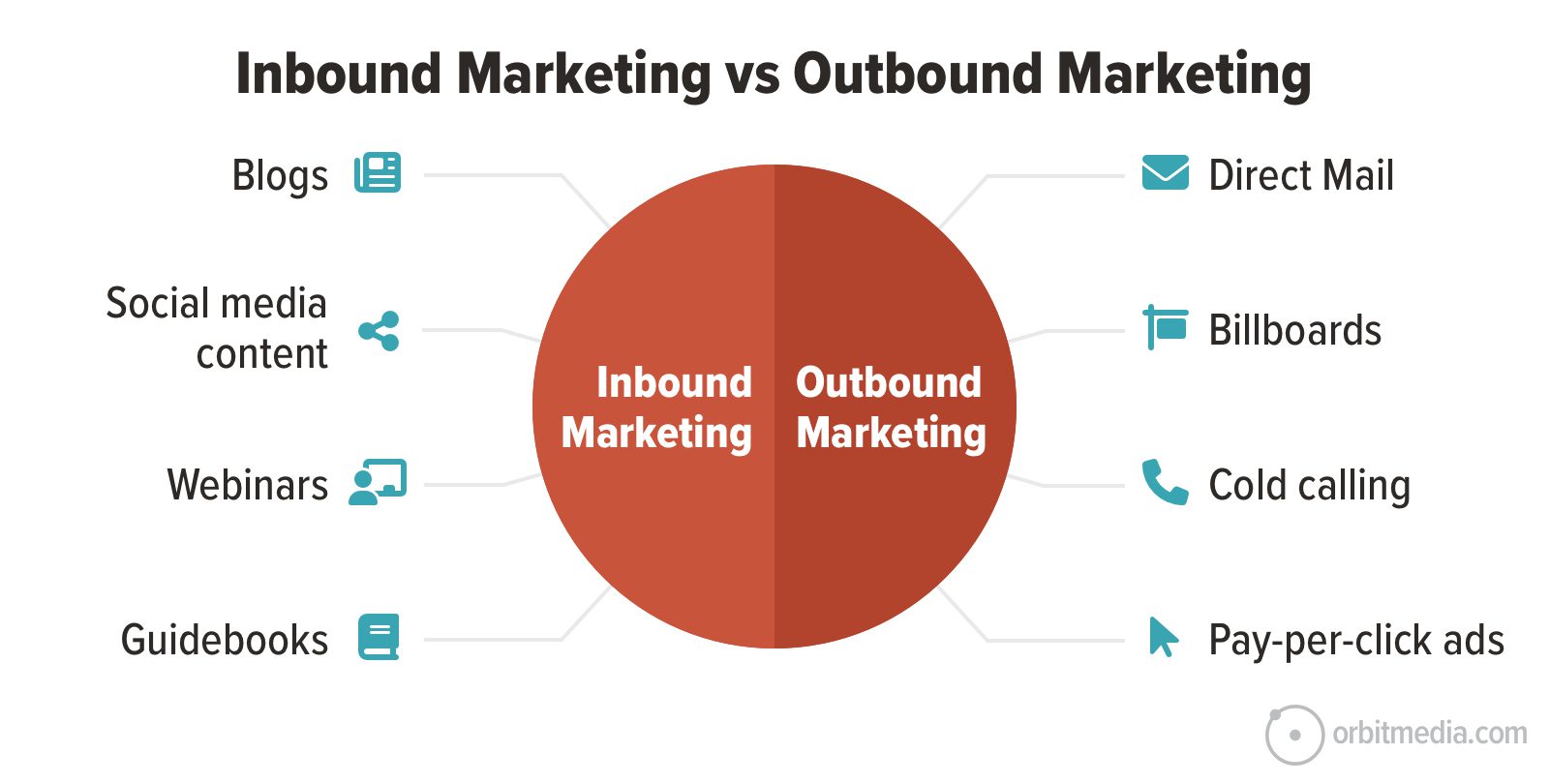 Essentials of inbound marketing
Essentials of inbound marketing
Search engine optimization, compelling content, answered questions, email capture… These are all words and phrases associated with inbound marketing. Let the potential customers come to you, and provide them with valuable content and guidance while encouraging them to convert.
Many inbound marketers know that customers are already searching for the products and services they’re interested in, so they believe that all they need to do is ensure their company is showing up in search results and/or social media. Seems easy enough, but there is a lot more to it.
1. Attract, engage, delight
The principles of inbound marketing are to attract, engage and delight. This requires much more than simply showing up on search results for a few keyphrases.
- Attract: The first step of winning a new lead is brand awareness. Using a well thought out content strategy, you can draw in new visitors. SEO and social media play a big role in this step.
- Engage: Win over your new leads through relatable and engaging content. Capture data through surveys, pop-ups and forms. Find out what they are looking for, their concerns and questions and provide effective answers and solutions.
- Delight: The last step is to ensure customer satisfaction. If someone has a good experience with your company, they are more likely to come back (and tell all their friends). Get feedback from customers, learn from your mistakes and spotlight what you did well and you’ll have more return customers in no time.
2. Create quality content
As already mentioned, inbound marketing is very similar to content marketing. But what does that really mean?
Content marketing is a strategy used to attract, engage and retain (sound familiar?) leads through valuable content. Creating and sharing content such as blog articles, podcasts, webinars, videos and more that establish expertise in your field and contribute to brand awareness.
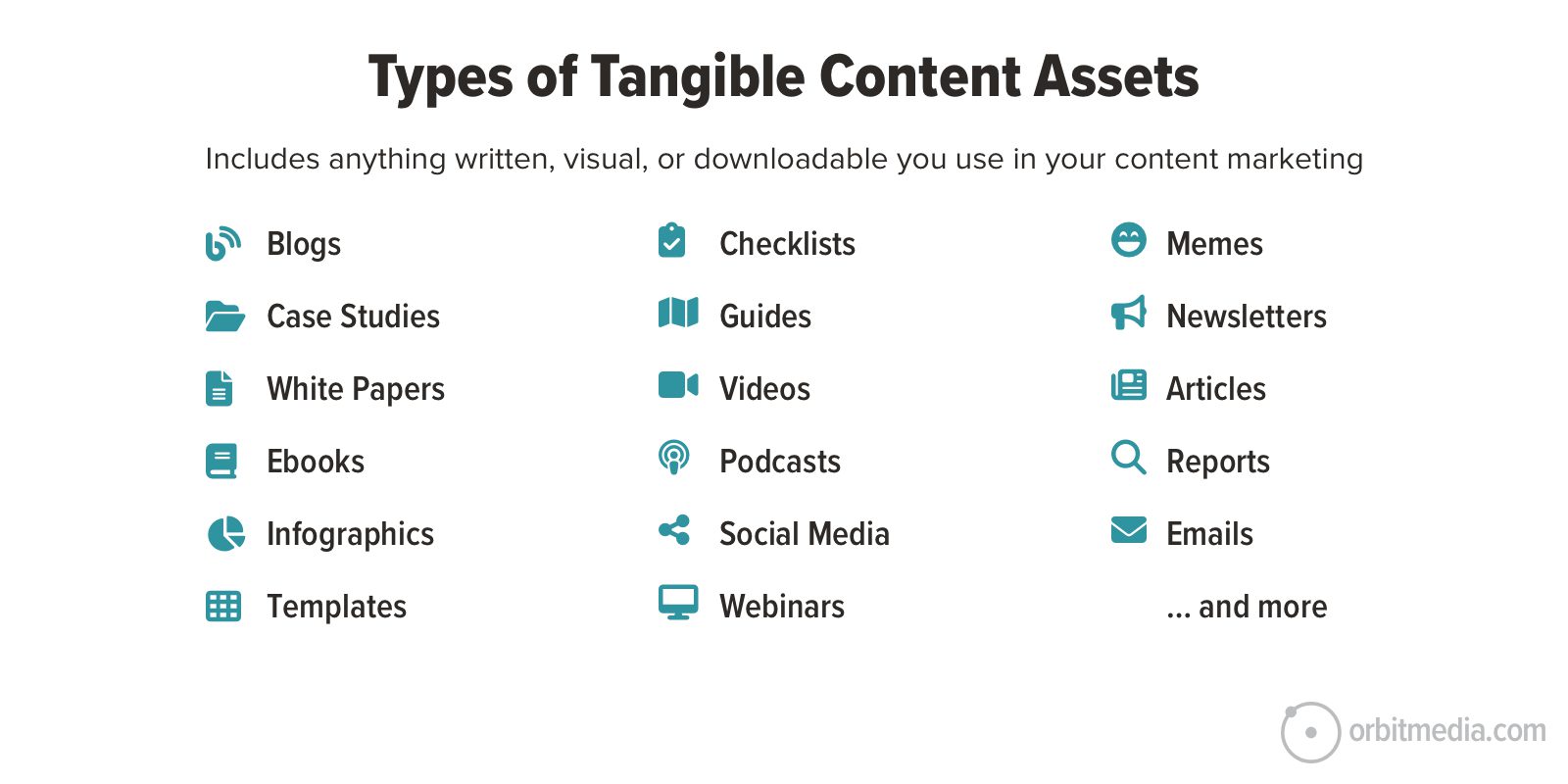
To attract prospects and keep them interested, it’s necessary that you have a well thought out content strategy that takes SEO and personalization into account. It’s a delicate balance between keeping up with what the masses are searching for, and tailoring your content to feel unique and personal to the needs of every buyer.
Get tips for launching an effective content strategy
3. Nurture leads
Attracting new leads and building brand awareness are important, but your marketing efforts shouldn’t end there. Gaining a new lead is an excellent start, but you also need to engage and nurture your potential clients.
- Use targeted content: Research and interview your leads to get a better understanding of their goals, interests, objectives, worries, etc. (AI can help you craft marketing personas as well). With this information, you can craft more targeted blog articles, videos and other pieces of relevant content to align with these different personas.
- Utilize automation tools: You can save time and energy using marketing automation tools. These can help segment your leads, making it easier and faster to push out targeted content.
- Lead scoring: Data from conversion events, traffic sources, social media interactions, etc. can all be used to help your marketing and sales team score, rank and prioritize leads.

Image source: saleswingsapp.com
Supporting outbound marketing efforts
Outbound marketing is heavily focused on driving brand awareness and reaching a wide range of people. When people think of marketing in the traditional sense, they often think of outbound marketing techniques: cold calling, TV commercials, industry events, etc.
While the methods may be more old-school, outbound marketing can still be very effective today and can be adapted to the digital landscape.
4. Use a variety of channels
Depending on your target audience and offerings, it can be helpful to use a range of channels to drive brand awareness. There are three main categories of outbound marketing:
- Traditional media: TV, radio, print and billboards.
- Digital platforms: Social media ads, display ads, search engine marketing.
- Direct engagement: Direct mail, email marketing campaigns and cold calling.
Digital platforms are effective for targeted marketing campaigns, direct engagement can often be more personalized, and traditional media is a great option for reaching a very broad audience. Consider dabbling in all three until you find what works best for you.
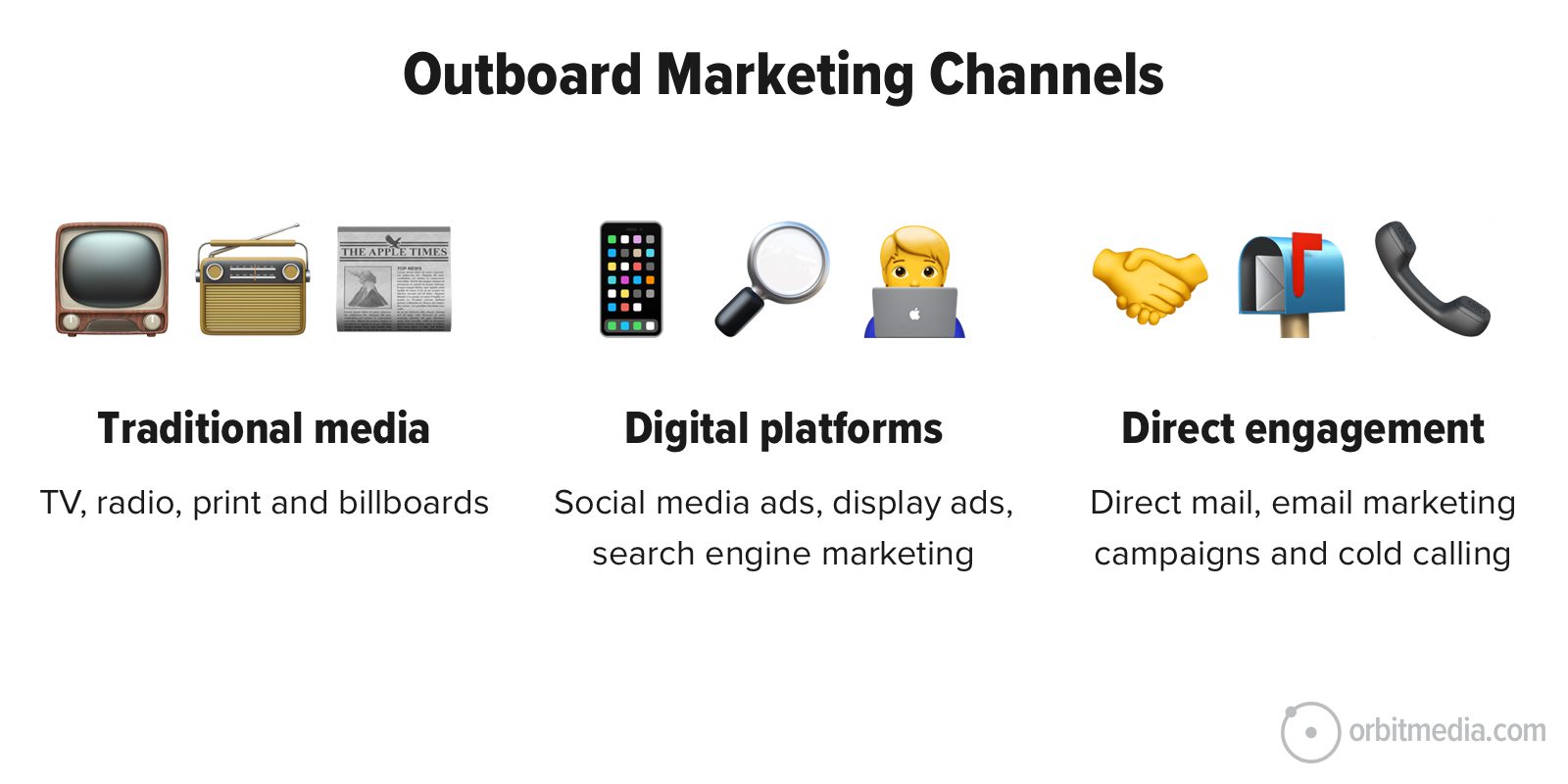 5. Automation tools
5. Automation tools
Marketing automation refers to platforms, tools and software that can streamline repetitive tasks like sending emails, posting on social media, managing leads, capturing and reporting data and more. For outbound marketing, this may look like:
- Creating and reporting on ad campaigns
- Social media management
- Sending cold emails and follow-ups
- Collecting information on potential leads
- Answering common questions and concerns
6. Personalization
One thing you want to be careful of when using automation tools or reaching out to a large audience is feeling too impersonal. Tailoring messages to specific audiences is a great way to make outbound marketing feel more personalized and can drive more engagement and conversions.
Even if you are sending the same message to a large number of people, craft copy that feels more personal and inviting. Consider tailoring certain messages to different audiences, considering the social media platform they are on, their traffic source and other factors.
Balancing the two
Inbound marketing is all about high-quality tailored content, and outbound marketing is about promoting your company and services to as many people as possible. So which is right for you?
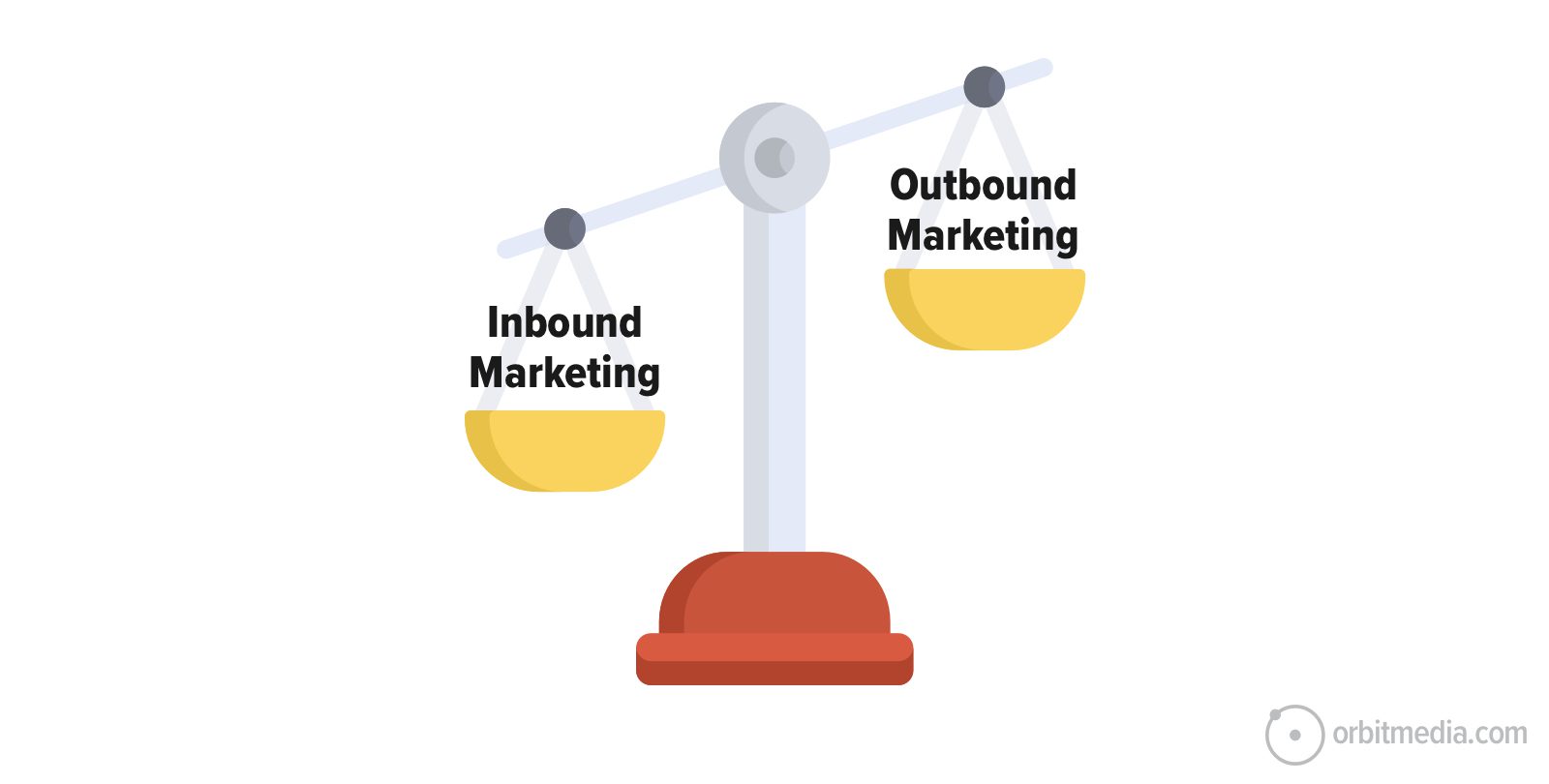 Luckily, you don’t have to choose between inbound or outbound marketing- you can and should use both methods. Many of us stray away from the more aggressive forms of outbound marketing, but the reality is that inbound marketing can at times be too passive. And in the ever-growing world of marketing, the lines are becoming even more blurred when differentiating between inbound and outbound marketing.
Luckily, you don’t have to choose between inbound or outbound marketing- you can and should use both methods. Many of us stray away from the more aggressive forms of outbound marketing, but the reality is that inbound marketing can at times be too passive. And in the ever-growing world of marketing, the lines are becoming even more blurred when differentiating between inbound and outbound marketing.
 |
Ben Jacobson, Chief Content Officer at InboundJunction“Too many marketers simply put up content with the hope that readers will be compelled to heed some call-to-action. That’s like throwing darts in the dark and hoping something will stick. It takes control away from you and makes your business goals all the more difficult to achieve. Let’s face it – sticking to a purely inbound style of marketing often doesn’t get the job done.” |
Get more insights in Ben’s inbound marketing strategy article >
Here are some tips to help you marry the two methods:
7. Evaluate effectiveness and refine your strategies
For some industries, outbound marketing may provide better results than inbound marketing, or vice versa. While utilizing both methods is helpful, measure the effectiveness of your campaigns and refine your strategies based on performance data. Some key indicators and metrics that can help you evaluate effectiveness include:
- Impressions
- Search engine rankings
- Cost per click
- Click-through rate
- Customer acquisition costs
- Return on investment
- Return on ad spend
Use this data to improve your current marketing strategies, or brainstorm new multivariate and A/B testing opportunities to find out what you can tweak for better results!
8. Follow up on outbound initiatives with inbound content
Use outbound tactics to get ads in front of a wider audience, then follow up using personalized and segmented content. When possible, ask for feedback from potential leads to learn more about their interests, challenges, concerns, and goals.
A buyer’s journey begins with awareness of your brand, product, or service. Once you have introduced your company to the buyer, utilize automation and lead scoring tools to narrow in on quality leads. Then build tailored blog articles, social media posts, webinars, and other inbound content.
9. Repurpose high-performing content
Make note of your high-performing content and find ways to repurpose those assets in your outbound or inbound marketing efforts. This could include blog posts that consistently rank, or specific mailers and print ads that attract more leads than others. If a certain message is bringing potential clients in, utilize that content elsewhere.
Here are some ideas:
- Transfer your most successful cold call talking points to a search-optimized landing page.
- Create social media content that reflects or talks about your most successful paid ad campaigns.
- Repurpose the script from a viral social media video in an email marketing campaign.
10. Compelling CTAs
Call to actions are a great way to guide your visitors down the conversion funnel, whether you reached them through inbound or outbound marketing tactics. The copy and formatting of your CTAs can play a big role in how readers interact with your page or blog.
Use strong, assertive language that makes it clear what you want the visitor to do. It should be obvious what the goal of your landing page or blog is, and you should use language that encourages the visitor to move forward.
Here’s an example of a CTA on Orbit’s website:
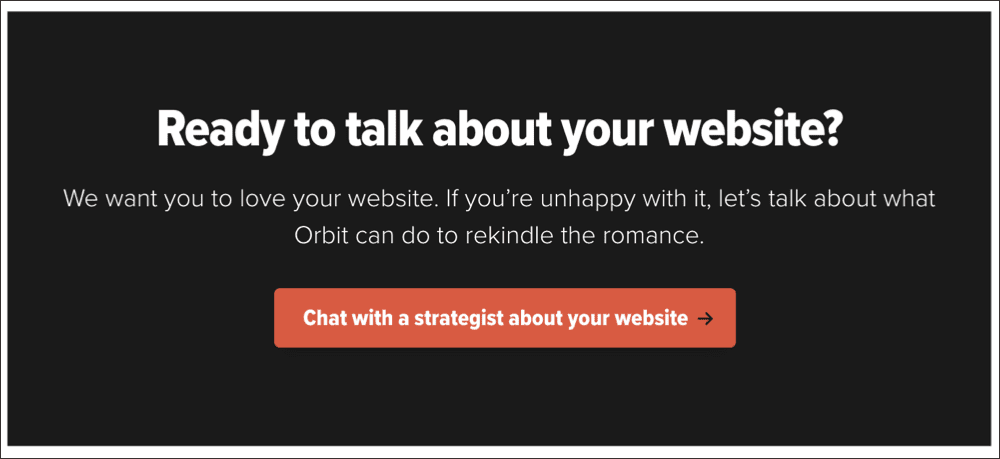 Generating leads with expert marketing
Generating leads with expert marketing
Inbound and outbound marketing share the same mission, to increase lead generation. Whatever your goals are for this month, quarter or year, balancing different marketing tactics is a great way to see a bump in lead generation and find out what strategies work best for your business.
A few things to keep in mind:
- Inbound and outbound marketing have many overlaps, especially in the digital marketing landscape.
- Personalization can improve both inbound and outbound strategies
- Content marketing and inbound marketing are often comparable
- Automation tools can improve efficiency
- Quality content is the key to attracting and engaging potential customers
I hope you’ll find some of these tips useful for supporting your lead generation goals. Looking for a marketing web design company with experience in lead generation? Orbit can help! Let us know what you’re looking for →




